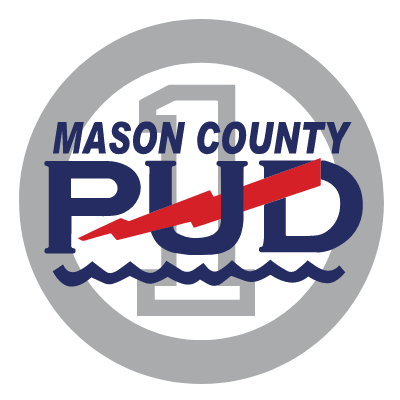- Authorized Consumption (AC) – volume of water used by consumers as shown through meter readings, fire-fighting, system flushing, tank cleaning and street cleaning.
- Average Daily Demand (ADD) – average volume of water a typical single family home uses each day measured in gallons per day.
- Distribution System Leakage (DSL) – water lost from system through leaking pipes, illegal water use, malfunctioning meters or meter reading errors. The volume difference of total water produced and authorized consumption (TP-AC). Percent DSL = [(TP-AC)/TP] x 100%.
- Total Water Produced (TP) – volume of water pumped from a well, diverted from a surface water or purchased from another water system.
- Water Use Efficiency Goal – a set target for water usage approved by the Board of Commissioners through the public process.
- Water Use Efficiency Measure – actions set by the Board of Commissioners to reduce water loss and water demand approved through the public process.
PUD 1 must meet conservation goals and standards, otherwise known as Water Use Efficiency (WUE). WUE is a proactive approach to protect public health and water supplies addressing growth demands, water rights, droughts and climate change that may lead to future long-term water disruptions due to declining water supplies.
The goals and measures approved by the District are implemented to reduce future water emergencies. Each year most PUD 1 water customers receive their annual Water Use Efficiency report as part of the Consumer Confidence Report. All Group A community water systems and most Group A transient non-community water systems must comply with Water Use Efficiency regulations.
Water Use Efficiency
- Contributes to long-term water supply reliability and public health protection.
- Promotes good stewardship of the state’s water resources.
- Ensures efficient operation and management of our water systems.
- Current Water Use Efficiency Goals.
Water Use Efficiency Reports
To access the most recent Water Quality Use and Efficiency reports for each water system, open the Consumer Confidence Reports section and then click on the name of the system listed. Reports are provided for most of our Group A water systems as required by DOH. The reports provide the distribution system leakage, the goals adopted for the water system, the progress towards meeting the goals and the measures taken to help meet the goals.
Water use efficiency
- Locate your water meter. It is usually found in a small concrete or plastic box near the street.
- If you need help locating your water meter, contact the PUD.
- Turn off all water at the house and in the yard, including water-using appliances in the home.
- Remember to shut off all indoor and outdoor faucets.
- Check and record the current meter reading.
- Wait at least 15 minutes before checking your meter again.
- Remember, DO NOT use any water while you are waiting!
- Read the water meter again. If the reading has changed, then you may have a leak that may require immediate attention.
Indoor
- Do not run sink faucet while brushing your teeth or shaving.
- Check toilets for leaks. Use food coloring or leak detection tablet in the tank. If color appears in the bowl within 10 minutes without flushing, there is a leak that requires immediate attention.
- Only run the dishwasher when full. Use dishwasher, if available, instead of hand wash dishes.
- Keep a bottle or pitcher of drinking water in the refrigerator. This eliminates letting the tap run while waiting for the water to get cold.
- Take showers instead of baths. Limit showers to 5 minutes.
- Put a bucket in the shower to capture water while waiting for it to warm up. Use this water for watering plants, flushing toilets, and other non-potable uses.
- Only run clothes washer when full.
- Only flush toilet when there are solids or semi-solids to flush.
Outdoor
- Water lawn in the evening or early morning to minimize water loss due to evaporation.
- Do not water when it is windy.
- Do not overwater. Add timers and rain sensors to sprinkler system so they run for a set period of time and do not run if it rains.
- Make sure your sprinkler system is working properly. Fix leaks and adjust sprinkler heads to eliminate over spray on driveways and paved surfaces.
- Water grass every other day or every 3 days. Grass typically only needs 1″ of water per week and can be watered for 30 minutes twice a week for deep roots.
- Some delicate shrubs and flowers require more frequent water, hand water these plants every day.
- Add mulch to your garden; plants lose less water when mulch is applied.
- Allow grass to go dormant, unless in a high traffic area.
- Do not let water run while washing your car, use a shut-off nozzle along with a bucket of soapy water.
- Do not spray-clean sidewalks, patios, driveways, or other hard surfaces, use a broom.
- Limit the filling of swimming pools and hot tubs.
